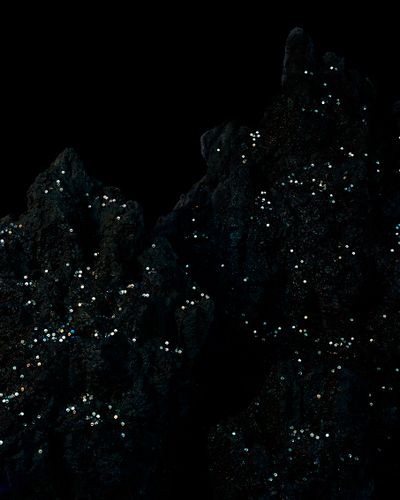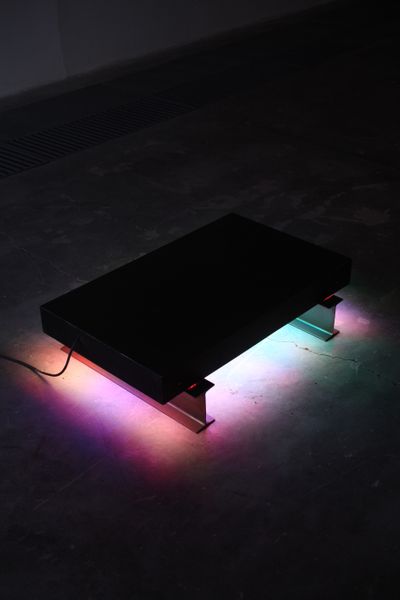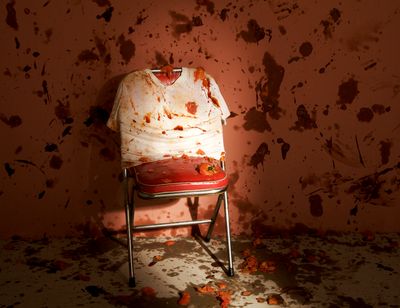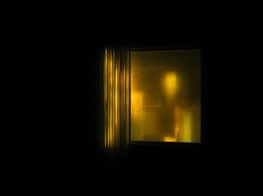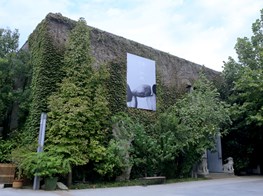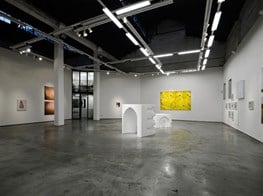Chen Wei
Chen Wei. Courtesy ShanghART Gallery, Beijing/Shanghai/Singapore. Photo: Liu Xing.
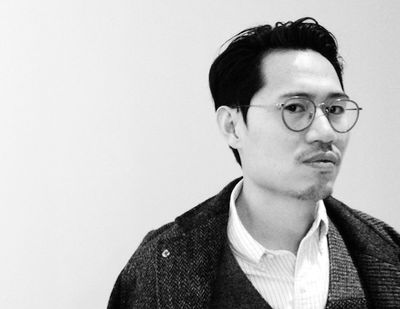
Chen Wei. Courtesy ShanghART Gallery, Beijing/Shanghai/Singapore. Photo: Liu Xing.
A pair of glasses with the lenses blown out, as if the viewer has seen something so hot his eyeballs exploded. A folding chair in a cell spattered with hurled tomatoes; an accomplice in the execution of a clown. Chinese photographer Chen Wei made his name staging and photographing scenes like these—sets from films that don't exist; stories untold, feelings not yet worked through. Born in Wenzhou, Zhejiang province, in 1980, Chen studied television at Zhejiang University of Media and Communications before quickly pivoting to experimental music and then contemporary art. He now works in Beijing, where he gave his first solo show with ShanghART from 21 May to 25 June this year. The self-titled exhibition presented installations of sculpture and lighting: elements he would previously have used in the creation of a photograph. In addition to showing his new photographic series 'Rockery' (2017), which depicts coins shimmering on dark scholars' rocks like stars against an unpolluted night sky, Chen installed a physical Wishing Well (2017) as part of the show: a brick pool filled with fragments of a fallen sculpture scattered with coins and illuminated by yellow waterproof lamps.
Chen also presents works that deviate from the magic narratives implied by earlier pieces. His 'Trouble' series (2017), for instance, is more interested in forms from urban landscapes. These works use glitched-out LED signage encased in iron and steel as a kind of found photography. Trouble #17033 goes so far as to display the signage face down, so only the light leaking onto the concrete floor can be made out. Amidst Chen's evolutions, one thing remains constant: he still approaches people and feelings obliquely, through human environments absent of people. In this conversation, Chen Wei demonstrates his skepticism regarding the worth of words in the face of everyday nuance.
SGYou studied TV camera operation at Zhejiang University of Media and Communications. That seems like a very pragmatic decision for someone with artistic aspirations. Why did you study that instead of an art degree?
CWI made the decision due to my family. My elder brother was engaged in the television industry at that time, so I chose this degree. With regards to my aspirations, it's quite natural for me to be an artist. When I was in college, I was like other students: playing football, watching movies, listening to music, performing in a band and falling in love. After I left school, I began to engage in sound performance and then tried to take photos and shoot videos. All of these experiences influenced my creation.
SG'In the Waves' shows sweaty clubbers not quite connecting, not hitting the highs that dance music promises. DJ Paul Oakenfold—a true EDM believer—invited you to shoot his show in Shanghai in 2015, and afterwards you drank wine and talked about love, equality and freedom; something you describe in a piece you wrote for Flash Art. Do you remember where you agreed and disagreed about these things?
CWWe had a happy and relaxed talk that day. [Novelist] Mian Mian and Paul's agent also took part in the conversation. It does not matter where I agreed or not. Everyone has his or her own idea, so I would respect any of his or her thoughts.
SGAt the end of your conversation with Oakenfold, he asked why you create these images, and you said 'because of tragedy'. What sort of tragedy?
CWThe tragic elements I'm talking about are not tragedies. They are the forces that drive my creation. They are more like a quality of spirit. Different people have different, subtle understandings of them. For example, in the 'New City' series, I hope to highlight the gap between people's imagination of the city and the reality, and the gap is one of the tragic elements.
SGYou've talked about how clubs in China went from being places of gathering for young artists and intellectuals, but also places for businessmen to party. You've said: 'While young people are always the main driving force for club culture, nowadays nobody talks about politics anymore, just money'. Are works like Coins and Rockery also critiques of capitalism?
CWCoins and Rockery are representations of tragic elements for me. These coins are found in a wishing well. People can exchange money for a wish at a very low price. Even though the wishes are unlikely to come true, they still throw coins into the well.
SGTo me your songs are less like EDM than Morrissey lyrics. 'This Charming Man' starts with the line about a 'punctured bicycle on a hillside desolate'. That could be a Chen Wei work, don't you think? An image that implies a narrative—how did the bike get there? The song creates these questions the same way images like Fragile (2011), glasses smashed on a desktop illuminated by sunlight, and Broken Tomato (2009), which comes from a version of the party game 'Truth or Dare', seem to have these latent backstories.
CWI'm glad to hear your interpretation of my works, but I did not design backstories in the creation of Fragile and Broken Tomato. Maybe I care more about the relationships between objects, their relationships with people, how they adapt to new environments and how they transmit information.
SGOn the subject of narrative, you've cited Borges and Kafka as influences. What stories and images in particular from their works have stayed with you?
CWI used to read their books a lot. Of course, I also read other books. All of these texts have been important nutrients for my growth.
SGWhat about your visual influences? In the sculptural aspect of your works, such as the precarious assemblage A chair and four 100 watt bulbs (2010), I see Man Ray's The Gift (1921): an iron with thumb tacks glued to its face.
CWI was influenced by all different kinds of people. But I think it is interesting for you to raise a question like this. Why do you think of these names, like Man Ray, when seeing my art. Why not Mario Merz, or Terayama Shūji? In fact, most of the time, it was my relationship with the world that affected my creation.
SGIn May you had a solo show at ShanghART in Beijing, almost a decade after your first solo exhibition, The Fabulist's Path, at Platform China in 2008. Looking back, how has your work evolved, and where would you like to take it?
CWNo one's relationship to the world is simple, nor can it be written down easily. My art, life and emotion are intertwined with each other. —[O]

